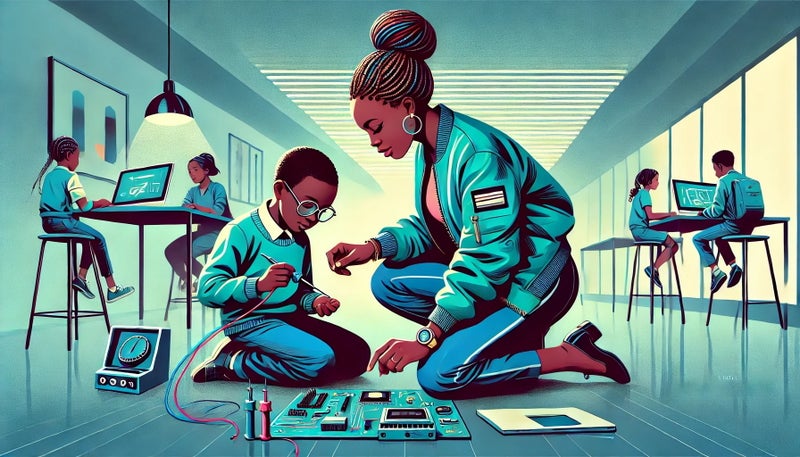Contents
- What's Going Wrong? Blended Learning's 3 MAJOR Issues
- Making Blended Learning Work in Four Steps
- The Real Future of Blended Classroom Learning
Is blended classroom learning just another of education's broken promises? Traditional schools slapped iPads onto Victorian-era teaching models and called it innovation. It's time to stop digitizing outdated methods and start building the 21st-century classroom that ACTUALLY levels students up.
Blended learning was supposed to be the best of both worlds - digital horsepower meets human reinforcement.
So why does it often feel like the worst of both instead?
Traditional education took the old Victorian classroom model and stuck it on shiny new 21st-century tech. Then they called it innovation and expected everything to fix itself.
Hot take: That's not a silver bullet. That's a Frankenstein monster of inefficiency that DEPLETES teachers and FAILS students.
The painful truth? The outdated education system expects you to shoulder its technological growing pains without proper support OR PLANNING.
More than four in ten K-12 staff members report feeling burned out constantly - higher than workers in ANY other profession. And barely one in six would recommend teaching as a career to others.
That's the industrial education complex's response to your passion.
But blended classroom learning doesn't have to play by the same outdated rules. Especially not because out-of-touch bureaucrats said so.
The concept isn't flawed - just the execution.
There's a reason your blended classroom feels more chaotic than cutting-edge. And we're here to tell you EXACTLY how to fix it.
What's Going Wrong? Blended Learning's 3 MAJOR Issues
We can't fix blended classroom learning without diagnosing what's actually breaking it.
The concept isn't flawed. But the execution IS a train wreck.
Here are the 3 MAJOR issues derailing your blended classroom right now:
Issue #1: Low Student Engagement
For years, bureaucrats have mandated students into passive listening.
Sit still. Face forward. Absorb information.
Now these same bureaucrats are shocked – SHOCKED! – that students can't suddenly transform into self-directed digital pioneers.
The brutal fact is that the system was NEVER built for self-motivation. It was built for compliance.
The numbers tell the grim story:
- 83% of educators report students struggling with concentration
- 81% point to tech - like cellphones - as major distractors
- 73% report ongoing class disruptions in schools where personal devices are accessible
Moving half a learning journey online WON'T magically transform classroom zombies into self-motivated, focused, autonomous learning machines.
Low motivation and endless distraction ISN'T on the student. It's on mismatched expectations and a catastrophe of surface-level implementation.
Here are three key engagement blockers:
- Low Self-Motivation – After years of wait for instructions, students suddenly face the expectation to drive their own digital learning journey. System-induced learned helplessness + half-baked tech implementation = recipe for disaster.
- Attention Overload – Students are expected to juggle WAY too much information across poorly connected mediums. Their genuine interest gets diluted by the sheer cognitive overload of managing tech, learning platforms, and wild expectations.
- Classroom Distractions – Every device becomes a Trojan horse for entertainment, social status wars, and infinite distraction – all smuggled directly into your carefully planned lessons by the very solutions promised to enhance them.
Issue #2: Maintaining Forward Momentum
Existing syllabi get halfway shifted onto new platforms, creating a monstrosity that's neither traditional nor fully digital.
The system has expected teachers to pick up its slack for DECADES. But now that slack spans two parallel universes – physical and digital – haphazardly duct-taped together with seems right tech.
Your students remain exactly as motivated as before (not very), but now you're expected to monitor their progress through a fragmented maze of badly integrated systems.
Here are three key momentum killers:
- Digital Spectator Syndrome – Pasting the same boring content into your LMS trains passive screen zombies. Content plays, eyes glaze, learning stops. Except now you can't see it happening to intervene.
- Data Fragmentation – The system hands you responsibility for unifying online and offline progress without tools, training, or time. Expected outcome: comprehensive insight. Actual outcome: no eyes on target.
- Inconsistent Pacing – Some students thrive with online learning and race ahead. Others lag behind. You're expected to conduct the educational orchestra forward while the musicians play from different sheets at different tempos in different rooms.
Issue #3: The Digital Gap
Technology promised education utopia FOR EVERYONE. But it delivered new barriers instead.
Not all students have the same access to tech. Not all teachers received solid training. And nobody bothered to SHOW the digital advantage before demanding everyone switch.
Over HALF (57%) of K-12 educators still believe students learn better from traditional print than digital materials. And only 9% flat-out disagree with them.
But the bureaucrats still went ahead with demanding unconditional buy-in without motivating the why.
Here are three key digital dividers:
- Access Discrepancies – Kids don't have the same access to technology, turning equal opportunity into an empty promise. Every technical hiccup widens the achievement gulf between those primed for a tech-forward environment and those that aren't.
- Teacher Hesitation – Without proper training, educators create scattered, superficial online content. Then they lose faith in the tech when their kid's results nosedive.
- Half-Measure Implementation – Schools keep one foot in traditional methods while attempting digital integration, creating a hybrid that delivers the worst of both worlds: digital distraction paired with analog speeds.
The system isn't just facing growing pains. It's suffering from a fundamental disconnect between what blended learning could be and the half-baked implementation most schools are stumbling through.
But here's the good news: These problems aren't inevitable. They're fixable.
And you're about to learn exactly how.
Making Blended Learning Work in Four Steps
The broken blended classroom isn't your fault. But fixing it is within your power.
Here's how to transform the classroom chaos into something that actually works:
Step 1: Become the Tech Pro Your Students Need
You're still a kick-4ss teacher. But your skills are degrading as we speak.
Employers anticipate that 39% of workers' core skills will change by 2030
But the administrators who pushed iPads into your classroom without training DON'T care. They got to check their digital transformation box and now they're happy to move on.
Meanwhile, you're left juggling Padlet on a prayer.
The divide is clear: Teachers who command technology create transformative learning experiences. Teachers who merely tolerate technology create digital worksheets.
Your kids need you to become AND STAY a technical expert.
Tech up or get left behind:
- Ditch the app buffet. Master 2-3 powerful tools that integrate seamlessly
- Block 45 minutes weekly for tech experimentation – treat it like a non-negotiable
- Build your tech tribe. A new tech-pushing colleague is more valuable than another mindless professional development session.
Step 2: Engineer Addictive Learning Experiences
Gaming companies have spent billions perfecting addiction loops that keep kids glued to screens for hours.
Why are we still forcing students through industrial-age instruction when we could harness those same psychological triggers for learning?
Traditional education treats student motivation as optional. Blended learning – done right – makes it the entire point.
Just look at 2 Hour Learning. They're building AI tutors that deliver dynamic, hyper-personalized learning for EVERY STUDENT.
The result? Students blast through a day's core academics in 2-hours flat. And they do it while snagging better results AND enjoying learning more.
Create learning students crave:
- Build visible progress systems. Nothing hooks a brain faster than watching a progress bar fill.
- Leverage technology to deliver feedback in minutes, not days. Motivation stalls with delayed consequences.
- Segment learning into conquerable chunks with escalating challenges – exactly like the games kids can't stop playing.
- Step back from lecturer status. Step up as the irreplaceable guide that keeps students in the game.
Open Opportunity: 2-Hour Learning is currently hunting for tech-forward teachers looking to shift into EdTech!
Step 3: Unleash Collaborative Learning
The traditional classroom is a factory.
Students sit in rows. Consume identical content. Produce standardized outputs. Alone.
This isn't preparing kids for 2025. It's preparing them for 1925.
True blended learning doesn't digitize this broken model. It strategically blends tech and hands-on practice to shoot past it.
When students accelerate through core academics faster, they unlock space for something far more impactful: real application and authentic collaboration.
Schools like Alpha have already crossed this bridge. They've compressed core academics into focused morning blocks, leaving HOURS free for life-skills workshops, creative application, and the types of collaborative projects that students actually look forward to.
Make collaboration thrive:
- Design challenges with stakes that matter. Let students solve real problems for real audiences.
- Create team structures that make individual contributions visible but collective success essential.
- Master facilitation, not presentation. Your value isn't in delivering content – it's in guiding individuals and supporting group dynamics.
- Teach critique as a skill, not an event. Students who can analyze others' work accelerate their own growth.
Open Opportunity: Alpha is building a nationwide network of guide-teachers who've outgrown the industrial classroom. Roles are HOT. Take a look!
Step 4: Let Student Feedback Drive Continuous Improvement
Your learning management system spits out data you don't need while missing the insights that would transform your teaching.
Meanwhile, the most valuable intelligence sits untapped right in front of you: your students' direct experience.
Corporate America spends billions measuring customer satisfaction. Education still treats student feedback as optional – or worse, irrelevant.
Break this pattern. Create feedback loops that capture real-time insights on what's working and what's failing.
When students shift from passive consumers to invested stakeholders, engagement soars.
Create effective feedback loops:
- Run daily micro-surveys (under 60 seconds) with a single focused question. Data accumulated over time reveals patterns invisible in the moment.
- Recruit a rotating student advisory team that meets weekly. Give them actual decision-making power.
- Implement changes visibly and immediately. Nothing kills feedback faster than asking for input, then ignoring it.
The Real Future of Blended Classroom Learning
Your classroom isn't broken because of technology. It's broken because bureaucrats bolted iPads onto a century-old system, called it innovation, and abandoned you to make it work.
Blended learning doesn't have to be a sinking ship. Because when done right, its potential is MASSIVE.
FSG's research found classrooms that implemented true blended learning saw significant boosts in STAAR assessment scores. And one district pilot saw students approaching grade level rocket up by 50 percentage points and students meeting standards surge 36 percentage points.
But these results don't happen by accident. They happen when teachers like you reject digital band-aids and embrace true transformation.
It's time to embrace the real blended learning model and turn your classroom chaos into academic excellence.
Are you still forcing students through yesterday's classroom on today's devices? Your students deserve an education built for the future, not preserved from a Victorian era past. This is your moment to reimagine blended classroom learning as it should have been all along.








